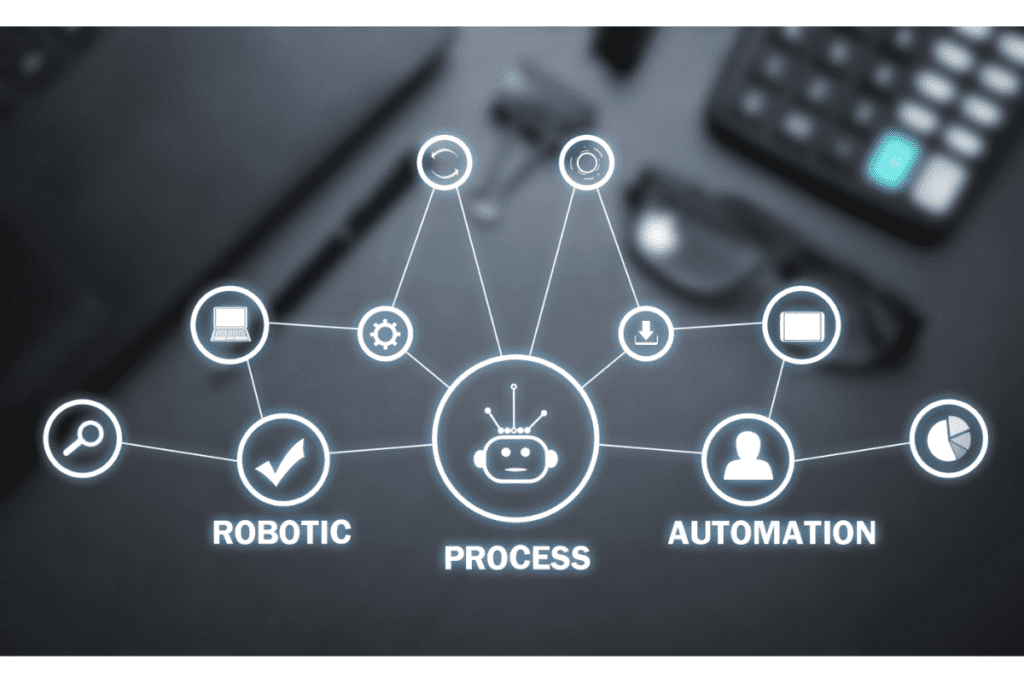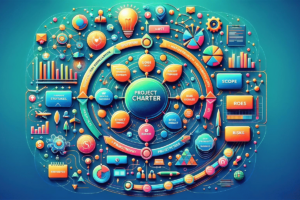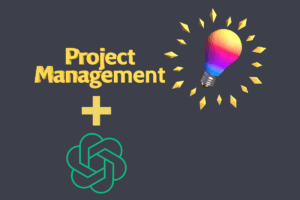Unlocking The Power Of AI In RPA: How Artificial Intelligence Enhances Robotic Process Automation
Does Robotic Process Automation (RPA) seem like an alien concept to you? It’s actually a game-changer, revolutionizing the way businesses operate by automating repetitive tasks. This blog post delves into The power of AI and RPA to take things up a notch, unlocking incredible capabilities for efficiency and decision-making.
Intrigued? Read on to discover how this dynamic duo is shaping the future of business process automation.
Key Takeaways
- AI and RPA team up to do jobs faster and better. They save time and make fewer mistakes.
- When you mix AI with RPA, bots become smarter. They learn from their work. This helps them solve problems by themselves.
- Bots can pull out facts from files using something called ‘automated data extraction.’ It makes sense of big data piles fast!
- Businesses can use bots for customer service needs too. These smart bots answer questions at any time and help solve problems quickly.
- Training staff well is key when using new AI tools in the workplace. A good plan for steady help will keep workers confident over time!
Understanding Robotic Process Automation (RPA) and Artificial Intelligence (AI)
-and-Artificial-Intelligence-(AI)-101126528.jpg)
Robotic Process Automation or RPA is a technology that uses software robots to automate repetitive tasks, thereby enhancing productivity and reducing errors. On the other hand, Artificial Intelligence (AI) simulates human intelligence in machines, allowing them to learn from experience and perform tasks like humans.
When combined in intelligent automation, AI can enhance the capabilities of RPA by enabling it to handle complex tasks, make decisions based on data analysis, and adapt to new situations.
This powerful combination provides businesses with an innovative way to streamline their processes for better efficiency and output quality.
What is RPA?
RPA stands for Robotic Process Automation. It is a type of software that mimics human actions. It uses bots to do repetitive tasks that take a lot of time. This way, employees can focus on more important work.
What is AI?
AI stands for Artificial Intelligence. It works like the human brain but in machines. AI makes use of computers to think and learn like humans. This ability helps it make smart choices and solve complex problems.
It can handle data that is not well organized and create its own ways to work.
Artificial intelligence can be seen as a big step up for robotic process automation robots, making them better at what they do. With AI, processes that involve hard tasks or lots of analysis become easy to do.
By understanding how AI works with RPA, you unlock more power from your bots!
How RPA and AI can be combined for intelligent automation
RPA and AI work well together. RPA does simple tasks. It uses rules to do jobs quickly and without making mistakes. AI, on the other hand, brings in smart action. It can learn from data to make better choices over time.
These two put together form “intelligent automation”. This allows for full process handling across many systems without needing a human touch. Jobs are done fast with this combined power of RPA and AI!
What are the Top Benefits of Combining AI in Enhancing RPA?

Artificial Intelligence significantly boosts the efficiency and productivity of Robotic Process Automation by enabling faster processing times. AI increases the quality and accuracy of work, minimizing errors caused by human intervention.
It provides enhanced decision-making capabilities through predictive analytics, improving business strategy and planning. AI-integrated RPA yields advanced data analysis, unearthing invaluable insights for improved operational performance.
Together, AI and RPA revolutionize workflow management, driving maximum value from automation efforts.
Increased efficiency and productivity
AI and RPA work together to make tasks fast and easy. Bots do the same jobs over and over without getting tired. They finish work quickly and on time. This means people can do other tasks that need human skills.
When AI is added, bots become smarter. They solve problems by themselves using what they learn from doing tasks times and again. This leads to a big jump in output of high-quality work in less time for companies that use this combo of AI-powered RPA.
Improved accuracy and quality of work
AI helps RPA to get better in its work. With AI, the bot makes fewer mistakes. This makes the work it does of higher quality. RPA bots can now understand and speak human language because of something called NLP that is a part of AI.
This means they do tasks right the first time, every time.
Because these robots are smart, they learn from their work and from any errors too. So, with each passing day, they offer more accurate results which adds value to your business. At last, you save money as well since there are few or no errors at all!
Enhanced decision-making capabilities
AI and RPA work well together to make better choices. They view a lot of facts fast. From this, they draw good points. These points help in making quick, smart choices for the company.
This removes guesswork from decisions. It helps find new ways to work better and faster as well. Each choice the bot makes is based on data which can be trusted over time. So, AI in RPA leads to stronger decision-making skills that aid the growth of your business.
Advanced data analysis and insights
AI adds more power to RPA for a deeper look into data. It can go through piles of numbers and facts fast. This mix of AI and RPA makes finding useful stuff in the data quicker. AI helps see patterns and trends that are not easy to spot.
These smart insights help make better choices for your business. With this, you can fix problems and grab chances to grow your firm quickly!
What Are Some Real-world Use Cases of AI and RPA in Intelligent Automation?
Discover how AI enhancements in RPA are transforming various industries with applications like advanced chatbots for responsive customer service. Learn about the role of automated data extraction and processing in streamlining business operations.
Explore the use of predictive analytics for accurate forecasting and trends prediction, as well as cognitive document processing for efficient handling of both structured and unstructured data.
These practical examples illustrate how AI-powered RPA paves the way to digital transformation across different fields.
Intelligent chatbots for customer service
Intelligent chatbots are now a big part of customer service. With AI and RPA, these bots can answer questions from customers fast. They also help with other tasks like setting up orders or fixing problems.
These chatbots work all day, every day. This lets them give help when people need it most – even in the middle of the night! Plus, since they use AI, they learn more as they work. So over time, they get better at solving tough problems and giving good answers to tricky questions.
The mix of AI and RPA makes for super smart bots that save time for both workers and customers. Workers no longer have to do simple jobs like booking a meeting or checking an order status – the bot does it! And this leaves workers free to focus on bigger tasks.
Companies who use these bots see less mistakes too because machines don’t get tired or distracted like humans sometimes do. This is why many brands today are using this smart tech combo for their customer support needs.
Automated data extraction and processing
Robots that use AI can do jobs faster and better. One of those jobs is pulling out facts from files. This is called “automated data extraction.” These robots can also put the data where it needs to be.
That’s “data processing.” Both RPA and AI make these tasks easier. They take away the need for people to do them by hand. With less work, there’s more time for other things! This helps many kinds of businesses in big ways.
Predictive analytics and forecasting
AI helps RPA to guess what will happen next. This is called predictive analytics and forecasting. With this, a business can know future trends. They can plan better and be ready for what comes next.
AI also checks lots of data fast. It finds signs of fraud that humans could miss. So, not only does the business run smoother, but it’s safer too!
Cognitive document processing
Cognitive document processing uses AI tools in RPA. It’s like giving brains to a robot. The bot learns and sorts out data from different types of papers. These can be bills, forms, or emails that have no set format.
Optical character recognition (OCR) helps the bot read written or printed text. Natural language processing (NLP) lets it understand and use human language. This makes it easy for bots to find key points in any paper file or email they scan with OCR skills.
Then, using NLP skills, they can know what these key points mean for the business.
How to Transform Your Organization by Implementing RPA and Generative AI?
Effectively combining AI and RPA requires careful planning, the right technologies, comprehensive data management, continuous training and support for employees, and a commitment to ongoing optimization of the implemented AI-powered RPA systems.
Read on to explore these strategies in detail for a successful digital transformation journey.
Identify processes suitable for AI integration
First, find the tasks that take a lot of time. Look for things that are done over and over. You also want to watch for tasks that have many steps. These all can be made better with AI.
Then, think about where you get lots of data. This could be from sales or customer calls or online forms. Wherever it is, AI can help sort this data fast and in a smart way! In the end, choose jobs with clear rules and goals for AI to work best.
Select the right AI technologies and tools
You need to pick the best AI tools for your project. Look at what tasks you want to make better. This will tell you what kind of AI tool you need. Some tools can read and understand text, like in emails or reports (this is called natural language processing).
Others can recognize images or even make smart choices based on data (these are cognitive decisions). Make sure your choice matches your needs.
Ensure proper data handling and privacy
Keeping data safe is key in using AI with RPA. All data must be handled in a secure way. This has to follow rules made to guard privacy. If AI and RPA tools are used, the data they take in needs strong protection from harm or theft.
Plus, any data that might show private information about people should be hidden or removed as needed. Secure systems help make sure that only allowed users can get access to this data.
Safe and private dealing of data makes your work with AI and RPA better trusted by others.
Provide training and support for employees
Training is key for workers to use AI. This new tech can feel hard at first. It is vital that staff learn how to best use it. A strong training plan should be set up by the project team.
Support does not end with training though. Staff must get steady help even after they have been trained on the new tools. This makes sure that all problems get fixed fast and people stay confident in using AI in their work roles.
Special one-on-one help works well too, especially for workers who may need extra time learning the ins and outs of these AI tools. Shared learning between team members can also boost their skills and trust in each other.
Continuously monitor and optimize AI-powered RPA systems
Keeping an eye on AI-powered RPA systems at all times is key. This helps to make sure they work well and do tasks right. One good way to do this is by using workforce analytics. It shows how digital workers are doing and finds problems fast.
You can also use SRE, which stands for “Site Reliability Engineering”. SRE uses AI to cut down on manual work and makes the most out of RPA systems. Both these methods help keep your RPA system in top shape.
They clear away issues before they become big problems.
FAQs
1. What does AI do in Robotic Process Automation (RPA)?
AI power and machine learning techniques used with RPA help to create intelligent process automation and cognitive automation. This enhances the way bots complete tasks.
2. Can we use Generative AI in RPA?
Yes, generative AI is a tool that combines with RPA robots for efficient workload management across the organization.
3. How can businesses apply AI and Machine Learning to their processes?
Businesses can use Machine Learning, Generative Ai or other AI solutions within their RPA workflows: this will automate complex cases and transform your business.
4. When should a business choose to implement a combination of AI and RPA?
When the task gets too hard for just one tool, it may be time for deploying both: an rpa bot plus an ai model! They work well together specially when you want to fully automate operations across any kind of firm or outfit.
5 . What are some benefits of using tools like UiPath Ai, Automation Anywhere or similar ones?
These kinds of software let firms dig into process mining; they also make easy the processing of documents in an smart fashion – leaving people free to focus on bigger things than mundane tasks!
6. How does combining artificial intelligence & robotic process automation improve how everything works?
The mix improves level by level what automation manages; it makes fast discover where each cog wheels needs attention right now! So your company becomes better bit by bit using these rpa capabilities plus some ai magic spun in!
Conclusion
Unlocking the power of AI in RPA is a big step forward. It lets robots do even harder tasks. This makes work faster and better for all types of businesses. Great things are coming from mixing AI and RPA!
If you liked this article, remember to subscribe to MiamiCloud.com. Connect. Learn. Innovate.







